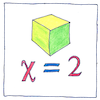Leonhard Euler
mathematics

|
Euler characteristic
The Euler characteristic or χ (a Greek letter pronounced like “sky” but without the “s”) of any geometric object is the number of vertices (corners) minus the number of edges plus the number of faces. The χ of any convex polyhedron (any three-dimensional geometric object with sharp vertices, straight edges, and flat faces) is 2. The χ of a cube is 2 (8 vertices - 12 edges + 6 faces). The χ of a triangular pyramid is also 2 (4 vertices - 6 edges + 4 faces). But the χ of nonconvex polyhedra is more interesting. The χ of a tetrahemihexahedron is 1 (6 vertices - 12 edges + 7 faces).
Topological invariant
Let me tell you about the χ of a sphere. You might think that the χ of a sphere would be 1 (0 vertices - 0 edges + 1 face); however, the χ of a sphere is 2. To understand this, first we need to realize no matter how you cut it, a sphere always remains a sphere. So cut it both horizontally and vertically. The two cuts cross each other in two places; these are its two vertices. The cuts also divide it into 4 faces that share 4 edges. Its χ is therefore (2 - 4 + 4) = 2. Cut the sphere vertically again at a right angle to the previous vertical cut. Now the sphere has 6 vertices, 12 edges, and 8 faces, retaining its χ of 2. No matter how you cut it, a sphere will always have a χ of 2. You can cut and flatten faces into any convex polyhedron and it still keeps its χ of 2.
Eyes
Your eyes, my dear, are jewelled spheres; each has a χ of two. Your eyes of blue, between us two, reflect the sky together here.



Science, like art, searches for the hidden unity of dissimilar things and tries to explain them.
See also in The book of science:
Readings in wikipedia: